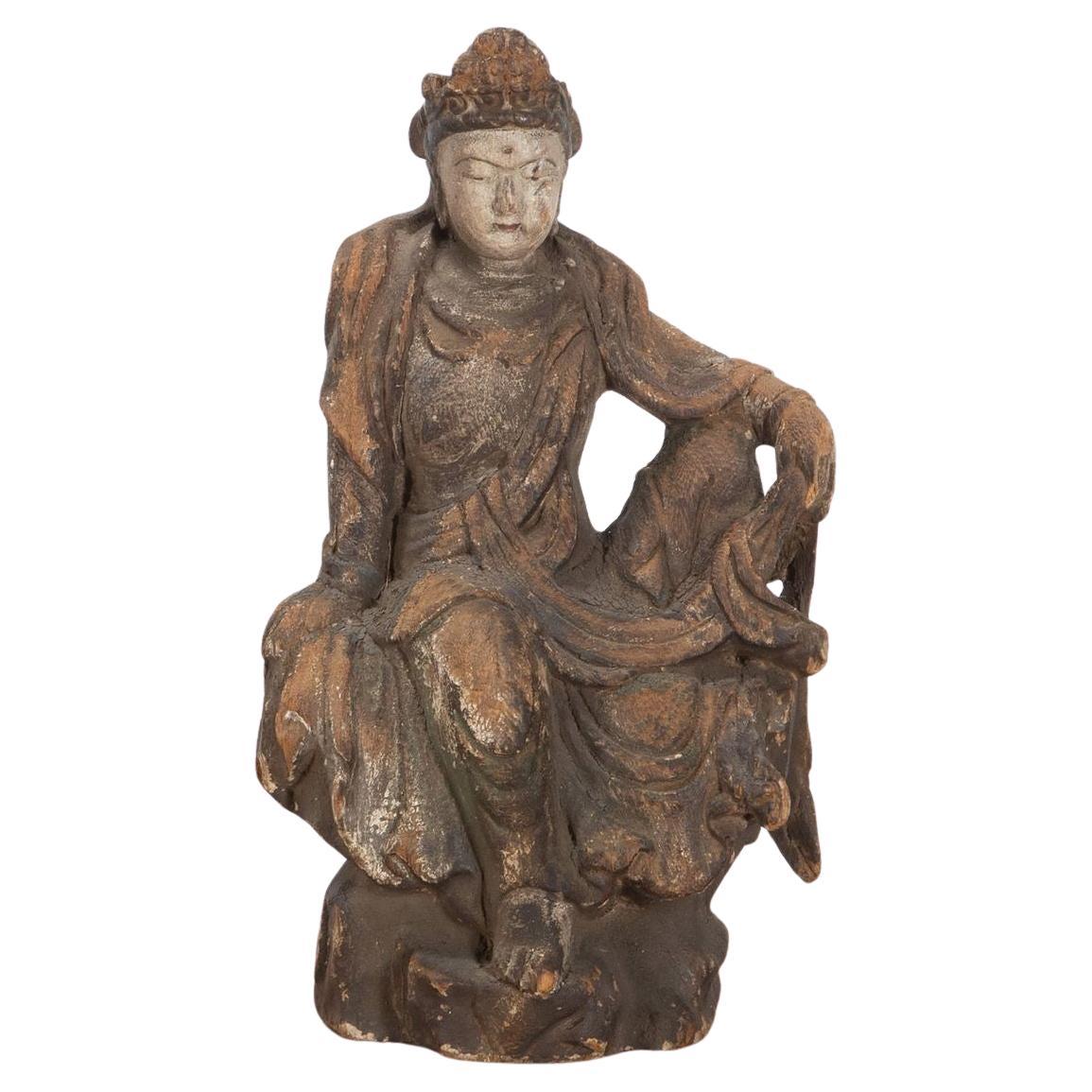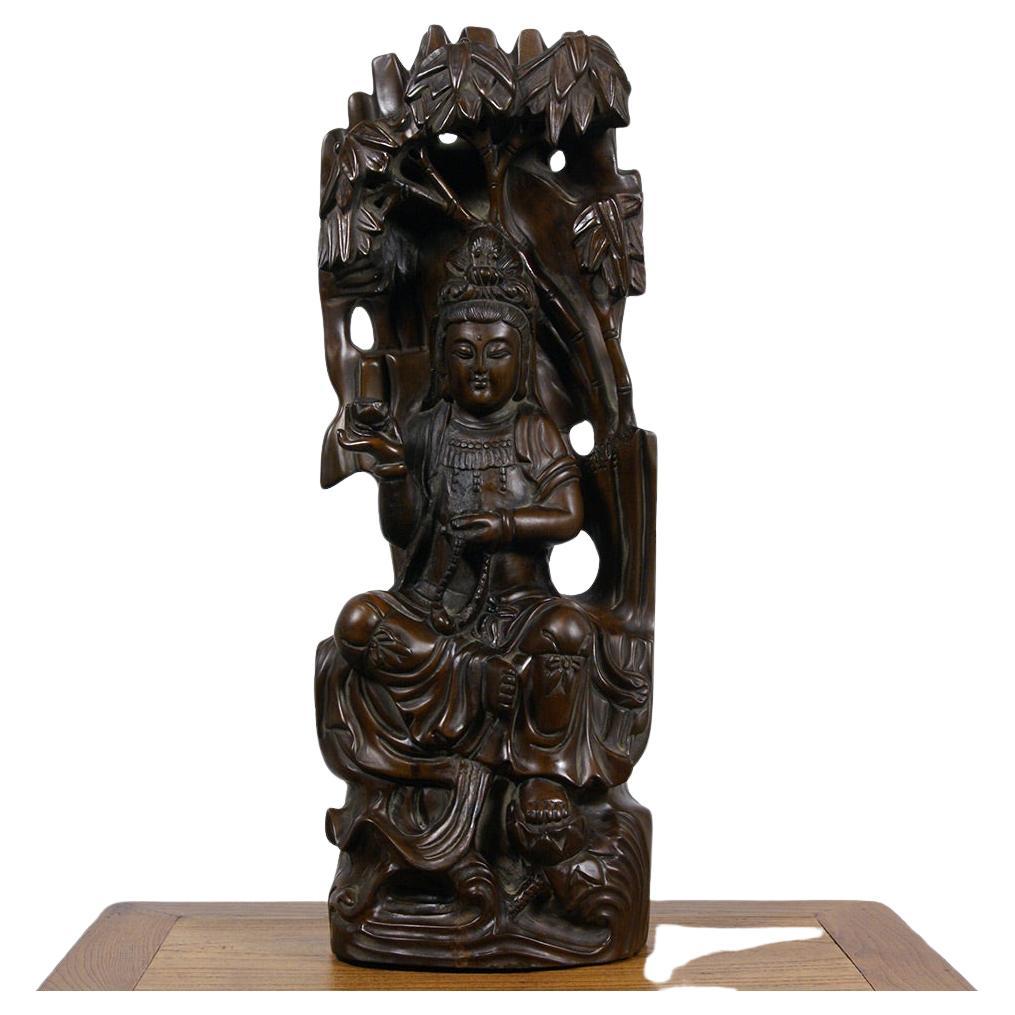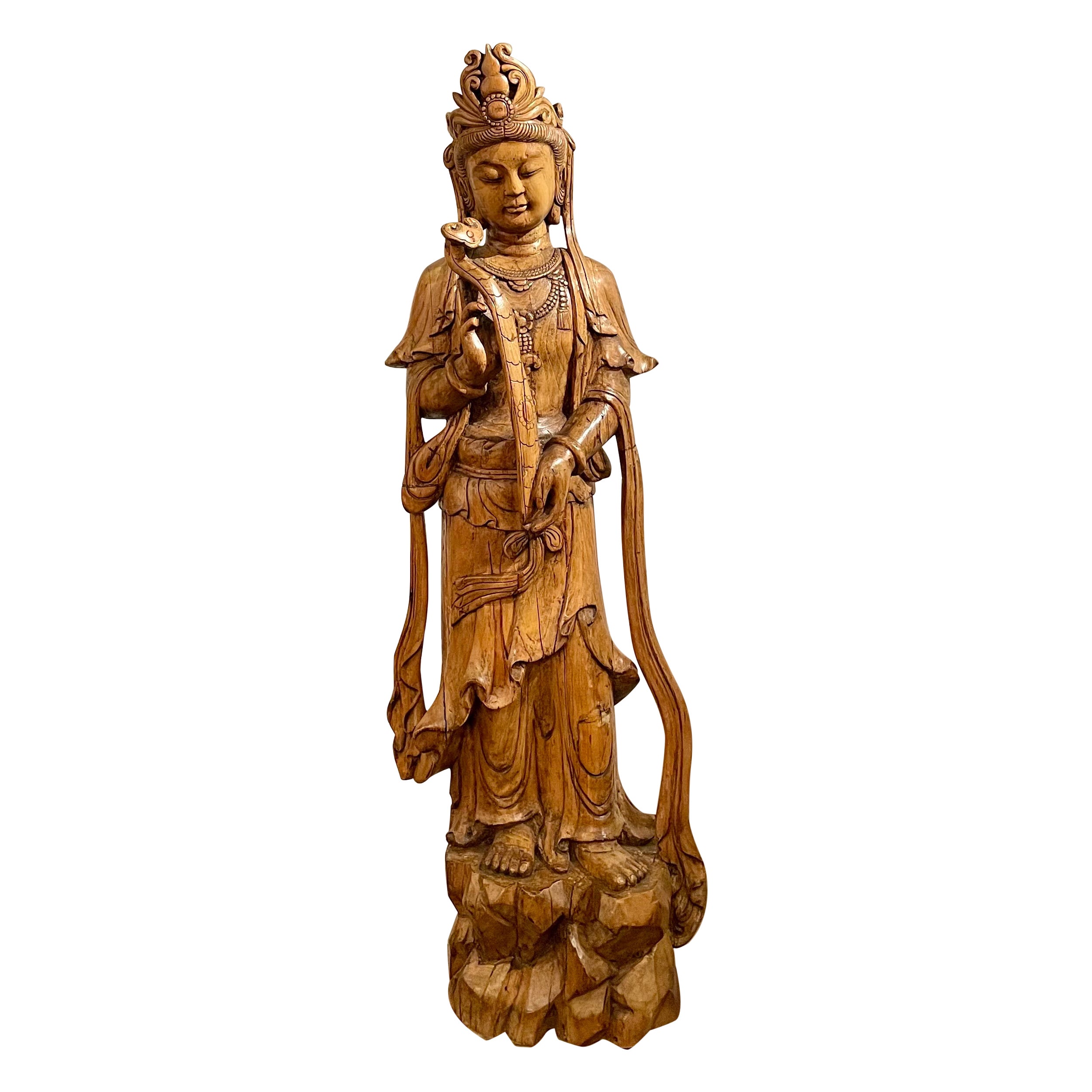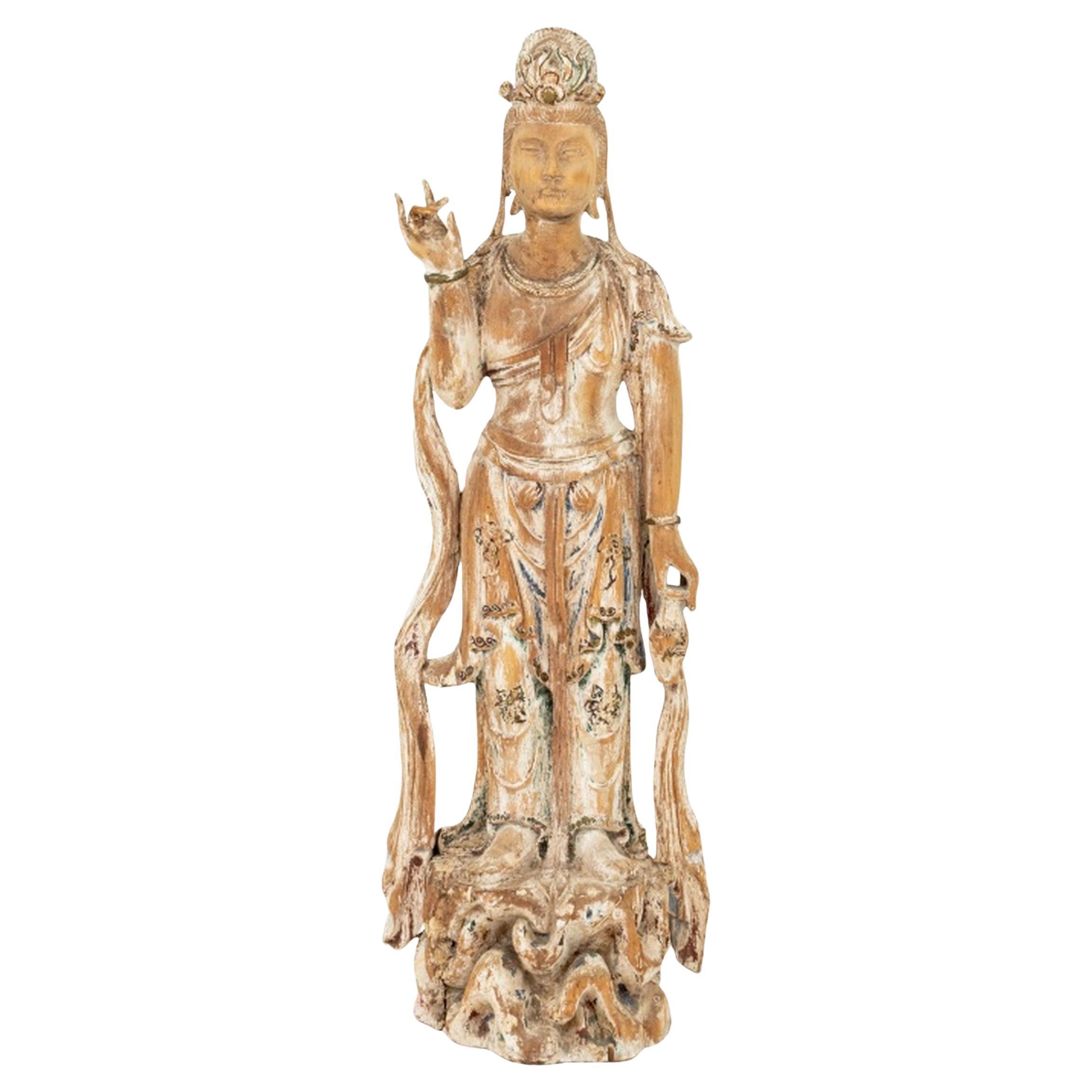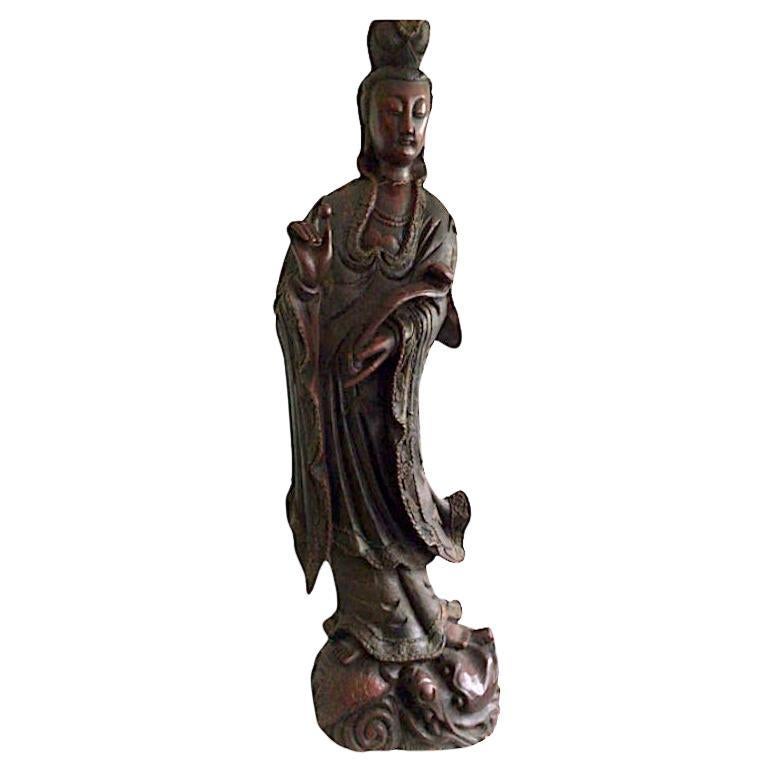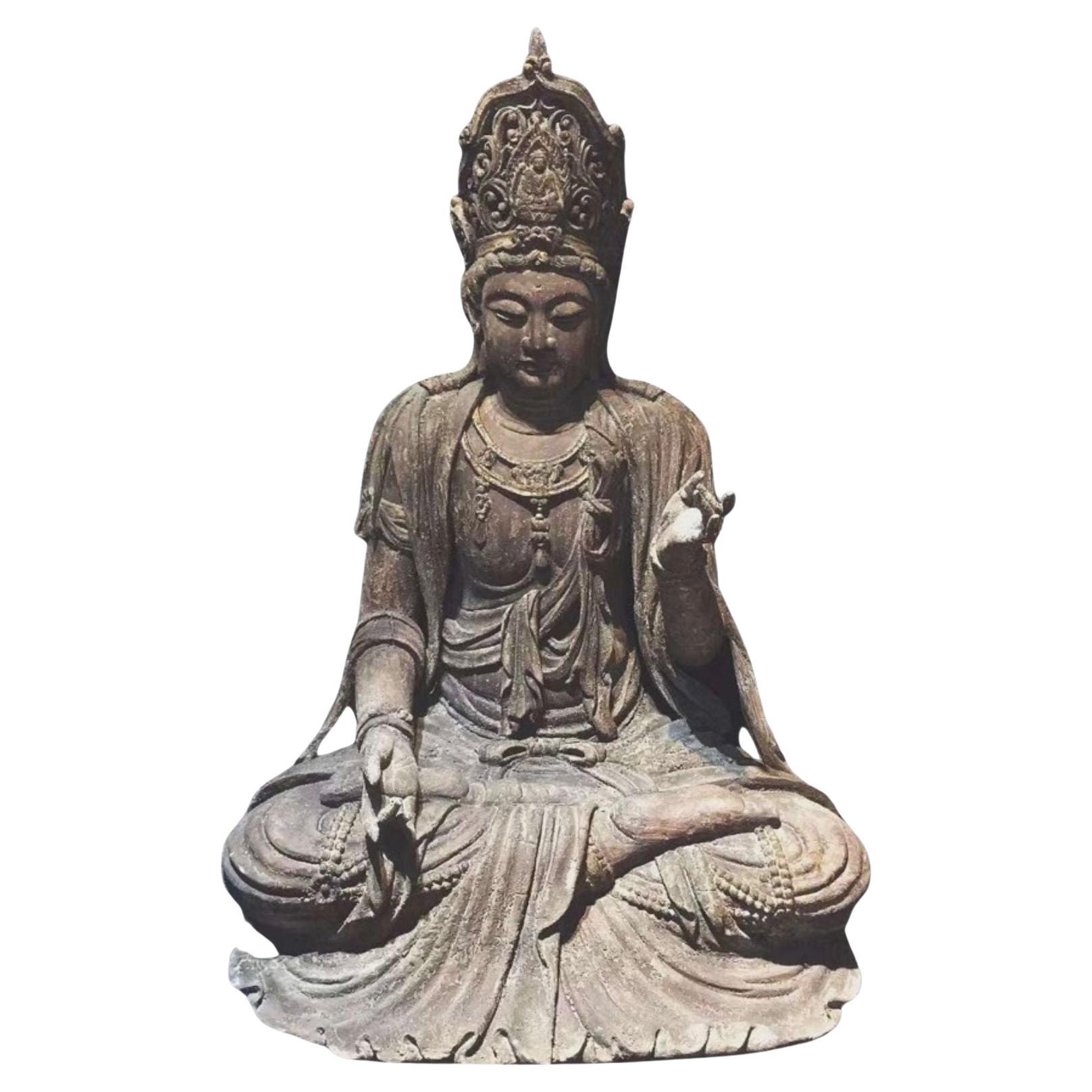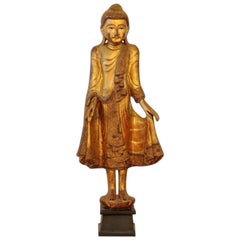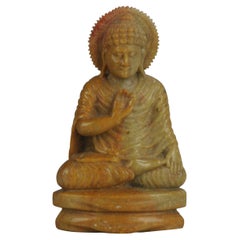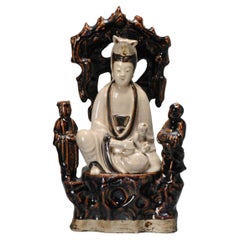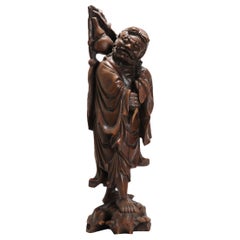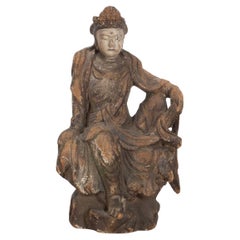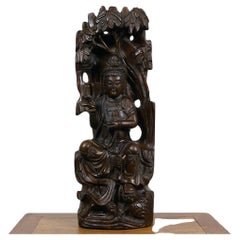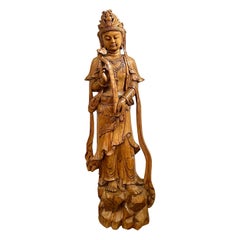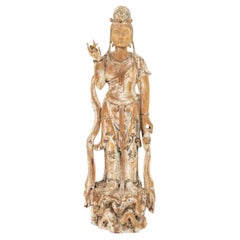Items Similar to Huge Chinese Carved Wood Statue of Guanyin Goddes Great Carving, 20th Century
Want more images or videos?
Request additional images or videos from the seller
1 of 5
Huge Chinese Carved Wood Statue of Guanyin Goddes Great Carving, 20th Century
$2,867.93
$3,585.5120% Off
£2,115.74
£2,645.1220% Off
€2,398
€2,99820% Off
CA$3,970.20
CA$4,963.5820% Off
A$4,304.86
A$5,381.9720% Off
CHF 2,284.54
CHF 2,856.1520% Off
MX$53,019.82
MX$66,285.8320% Off
NOK 28,315.41
NOK 35,400.1720% Off
SEK 26,723.24
SEK 33,409.6220% Off
DKK 18,257.25
DKK 22,825.3720% Off
About the Item
Huge and beautifully carved statue of a Guanyin. She is sitting on a throne.
Guanyin, Guan Yin or Kuan Yin (/ˌɡwɑːnˈjɪn/) is the most commonly used Chinese translation of the bodhisattva known as Avalokiteśvara. Guanyin is the Buddhist bodhisattva associated with compassion. In the East Asian world, Guanyin is the equivalent term for Avalokitesvara Bodhisattva. Guanyin also refers to the bodhisattva as adopted by other Eastern religions. She was first given the appellation of "Goddess of Mercy" or the Mercy Goddess by Jesuit missionaries in China. The Chinese name Guanyin is short for Guanshiyin, which means " Perceives the Sounds of the World." On the 19th day of the 6th lunar month Guan Shi Yin's attainment of Buddhahood is celebrated.
Additional information:
Material: Wood
Region of Origin: China
Period: 20th century
Age: ca 1900
Condition: Overall Condition Overall in Perfect condition, no real damages found (just some minimal age signs like some fritting at back 2 or 3 spots)
Dimension: 40 W x 25 D x 82 H cm
- Dimensions:Height: 32.29 in (82 cm)Width: 15.75 in (40 cm)Depth: 9.85 in (25 cm)
- Materials and Techniques:
- Place of Origin:
- Period:
- Date of Manufacture:20th Century
- Condition:Overall Condition Overall in Perfect condition, no real damages found (just some minimal age signs like some fritting at back 2 or 3 spots).
- Seller Location:Amsterdam, NL
- Reference Number:Seller: 1336805054331stDibs: LU4863235796332
About the Seller
5.0
Gold Seller
Premium sellers maintaining a 4.3+ rating and 24-hour response times
Established in 2015
1stDibs seller since 2019
269 sales on 1stDibs
Typical response time: 6 hours
- ShippingRetrieving quote...Shipping from: Amsterdam, Netherlands
- Return Policy
Authenticity Guarantee
In the unlikely event there’s an issue with an item’s authenticity, contact us within 1 year for a full refund. DetailsMoney-Back Guarantee
If your item is not as described, is damaged in transit, or does not arrive, contact us within 7 days for a full refund. Details24-Hour Cancellation
You have a 24-hour grace period in which to reconsider your purchase, with no questions asked.Vetted Professional Sellers
Our world-class sellers must adhere to strict standards for service and quality, maintaining the integrity of our listings.Price-Match Guarantee
If you find that a seller listed the same item for a lower price elsewhere, we’ll match it.Trusted Global Delivery
Our best-in-class carrier network provides specialized shipping options worldwide, including custom delivery.More From This Seller
View AllHuge 20th Century Thai Carved Wood Statue of a Buddha Gold Great Carving
Located in Amsterdam, Noord Holland
Huge and beautifully carved statue of a Buddha in sitting position. It's very large, a normal sized plates is added in 1 of the pictures for comparison.
A beautiful artifact, it s...
Category
20th Century Thai Ceramics
Materials
Wood
$2,861 Sale Price
20% Off
Lovely Qing Dynasty Chinese Soapstone Statue Nicely Carved Praying Figure
Located in Amsterdam, Noord Holland
Lovely Chinese Statue. The artist really did it's best on this one.
Additional information:
Material: Soapstone
Type: Statues
Region of Origin: China
Period: ca 1900 Qing (1661 - 1...
Category
Antique 19th Century Chinese Figurative Sculptures
Materials
Soapstone
$667 Sale Price
20% Off
Antique Ming Period Cizhou Statue of a Guanyin China Chinese Porcelain
Located in Amsterdam, Noord Holland
Chinese statue representing Kwan Yin/ Guanyin seated in rajalilasana on a throne, holding a child on her knees, two servants on either side. Cizhou porcelain with cream and brown gla...
Category
Antique 16th Century Chinese Ming Ceramics
Materials
Porcelain
$4,781 Sale Price
20% Off
Fine Chinese Carved Wood Statue of Lady with Parasol, 1900
Located in Amsterdam, Noord Holland
Ca 1900 Fine Chinese Carved Wood Statue of a lady with Parasol. China, finely carved wooden statue.
Additional information:
Material: Wood / Bamboo
Region of Origin: China
Period: 19th century
China Dynasty Period: Qing (1661 - 1912)
Condition: Condition Some damage and broken pieces to robe, foot and hand...
Category
Antique 19th Century Chinese Qing Figurative Sculptures
Materials
Wood
Fine Chinese Carved Wood Statue of Lady with Parasol, ca 1900
Located in Amsterdam, Noord Holland
Ca 1900 Fine Chinese Carved Wood Statue of a lady with Parasol.
Additional information:
Material: Wood
Region of Origin: China
Period: 19th century
China Dynasty Period: Qing (1661 ...
Category
Antique 19th Century Chinese Qing Figurative Sculptures
Materials
Wood
Antique Chinese Bronze Statue Guanyin China 19th / 20th century
Located in Amsterdam, Noord Holland
BRONZE top level Chinese statue
Qing period, 19th century.
Condition
29.5cm
Period
19th century
Category
Antique 19th Century Japanese Edo Metalwork
Materials
Porcelain
$897 Sale Price
20% Off
You May Also Like
Early 17th Century Carved Wood Figure of Guanyin
Located in Gloucestershire, GB
17th Century carved figure of Guanyin in Rajalalitasana position.
Seated on rock with the right arm rested on the right knee. The figures are wearing loose robes that open at the ch...
Category
Antique 17th Century Chinese Figurative Sculptures
Materials
Wood
Mid 20th Century Chinese Wood Carved Kwan Yin Statuary
Located in Pomona, CA
This magnificent vintage Chinese Wood Carved Kwan Yin Statuary has intricate carving works. It is all hand made and hand carved Kwan Yin sitting under the tree and holding a flower i...
Category
Mid-20th Century Chinese Chinese Export Figurative Sculptures
Materials
Boxwood
Antique Chinese Carved Wood Standing Sculpture of Quan Yin Figure, Circa 1890's.
Located in New Orleans, LA
Antique Chinese Carved Wood Standing Sculpture of Quan Yin Figure, Circa 1890's.
The figure of the sculptor is a Buddhist symbol of enlightenment and compassion.
Category
Antique Late 19th Century Chinese Figurative Sculptures
Materials
Wood
Chinese Carved Wood Guanyin Sculpture
Located in Astoria, NY
Chinese Carved Wood Standing Guanyin Sculpture, with remnants of gesso and polychrome paint. 49.5" H x 18" W x 11.5" D. Provenance: From a New York City Collection.
Category
Antique 19th Century Chinese Qing Sculptures and Carvings
Materials
Gesso, Wood
1920s Carved Wood Guanyin Statue
Located in Tarrytown, NY
1920s Carved Wood Guanyin Statue
Beautifully fine carving details
Damage shown in pictures
Crack in neck
Category
Vintage 1920s Sculptures and Carvings
Materials
Wood
A Large Chinese Carved Wood Figure of Guanyin, Late Qing Dynasty
Located in ARMADALE, VIC
Description:
A singular example of Guanyin. Deviating from the Bodhisattva’s conventional pose of ‘royal ease’, the figure is instead seated in the meditative padmasana, or ‘lotus position’, rendering this Guanyin something of a rarity. An Apana more typically associated with depictions of Buddhas, Guanyin assuming this pose immediately signifies this figure as one of particular spiritual reverence. Both feet are revealed crossed upon one another from beneath fabric which spills before her, her left palm turned upward with her hand resting upon her left knee and her right raised in a relaxed gesture. Adorned with a diadem housing a depiction of Amitabha Buddha, her own spiritual guide, she exudes an air of tranquil regality, further characterised by her numerous strings of beads and elaborately fastened dhoti, attire traditionally reserved for Indian princes. Though the figure’s dress is Indian her face is undoubtedly exemplifying artistic Chinese beauty standards. Her face is soft and rounded, full in both the lips and cheeks, with eyes that restfully peer down, as though she is watching over the worries of mankind with compassion.
Notes on the item:
Guanyin is the Chinese interpretation of Avalokiteshvara, the Indian Bodhisattva of compassion. The term “Bodhisattva” is derived from the Sanskrit “Bodhi”, meaning ‘awakening’ or ‘enlightenment’, combined with “Sattva”, meaning ‘spirit’ or ‘being’, referring to one on the path to achieving enlightenment. Bodhisattvas in Mayahana Buddhism are recognised as figures who have effectively achieved enlightenment yet relinquish their accension to nirvana in order to remain amongst mankind in the ultimate act of compassion to aid as spiritual guides. As such, the Bodhisattva inhabit a liminal space between samsara and nirvana; enlightened beings that maintain a relationship with humanity that buddhas cannot, as attaining Buddhahood necessitates the abandonment of all worldly attachments, including mankind. Guanyin’s very name, ‘One who hears the cries of the world’ highlights this role as a compassionate figure who acknowledges the suffering and strife of man. Along with Mahāsthāmaprāpta, a fellow bodhisattva, Guanyin serves as an attendant to Buddha Amitabha, with these three deities recognised as the Three Sages of Western Pure Land Buddhism, a sect of Mayahana Buddhism popular in East Asia.
Avalokiteshvara is commonly posited to have been adopted from Indian Buddhism into China as Guanyin around 200-400 CE, however it was the Tang dynasty (618-907) which saw the popularisation of the deity. By the Ming (1358–1644) and Qing (1644–1911) dynasties, Guanyin held the position as the most popular female deity in China. The unique state of religion in China held no monolithic canon regarding Buddhism and saw the assimilation of several belief systems, primarily Daoism, Buddhism and Confucianism. Consequently, Guanyin became a deity to be revered beyond Buddhism alone, appointed as both an official imperial deity and Daoist deity in the 12th century. Guanyin may also be seen to fulfil the role of idealised femininity as prescribed by Confucianism, with the scarcity of female Chinese deities perhaps accounting for the gradual gender shift Guanyin underwent.
The Indian Avalokiteshvara is unequivocally recognised as male, whilst the supposed gender of Guanyin remains contentious. Although there is a clear shift from the masculine Avalokiteshvara towards a more feminine representation, it is unclear if Guanyin is understood to be entirely feminine, to inhabit qualities of both genders or to be elevated beyond gender entirely, embodying neither. Depictions of Guanyin are highly androgynous, which some believe lends credence towards Guanyin symbolising the unity of dualistic forces as recognised in Daoism, displaying the anthropomorphism of yin and yang.
Comparative Analysis:
Market comparisons of similar Qing Dynasty polychrome figures of Guanyin include lot 767 (no.2) From Christies ‘Important Chinese Ceramics and Works of Art,’ New York, 25 March 2022, with the price realised USD 52,920 (Estimate USD 20,000 – USD 30,000). Christies also auctioned a comparable polychrome Guanyin...
Category
Antique Late 19th Century Chinese Qing Sculptures and Carvings
Materials
Hardwood
More Ways To Browse
Goddess Of Mercy
Guanyin Sculpture
Wood Guanyin
Chinese Wood Guanyin
Guanyin Carved Wood
Guanyin Statue
Kuan Yin
Antique Italian Figurines
Arab Warriors
Bronze Sculpture On Plinth
Car Hood Ornaments
French Angel Sculpture
French Bronze Figurines
Glass Sailboat
Indonesian Bronze
Michelangelo Buonarroti
Mid Century Mermaid
Peach Sculpture
